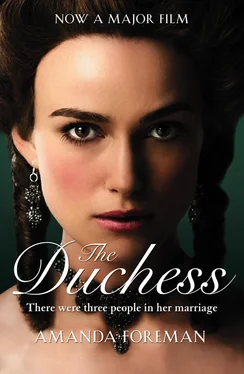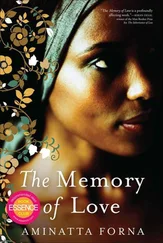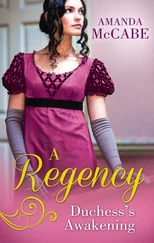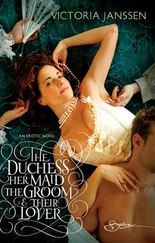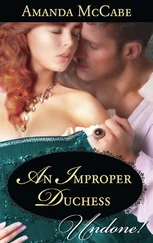The ‘Stockholm Syndrome’ came upon me suddenly, and I was caught even before I noticed it happening. One day in the Public Record Office at Kew, while reading a vicious letter from one of Georgiana’s rivals, I found myself becoming furious on her behalf. This was the beginning of my obsession with Georgiana, fuelled by frustration at the empty spaces in the Chatsworth archives where someone had either destroyed her letters or censored them with black ink. It only began to wane after I had filled in the missing days and months in Georgiana’s life from other sources: the archives at Castle Howard, private collections, the British Library, and libraries and record offices all over Britain.
By the time I had consigned Georgiana to the page a different picture of her had emerged. Previous accounts portrayed her as a charismatic but flighty woman; I see her as courageous and vulnerable. Georgiana indeed suffered from the instability which often accompanies intelligent and sensitive characters. She was thrust into public life at the age of sixteen, unprepared for the pressures that quickly followed and unsupported in a cold and loveless marriage. Though most of her contemporaries adored her because she seemed so natural and vibrant, only a few knew how tormented she was by self-doubt and loneliness. Georgiana was not content to lead the fashionable set nor merely to host soirées for the Whig party, instead she became an adept political campaigner and negotiator, respected by the Whigs and feared by her adversaries. She was the first woman to conduct a modern electoral campaign, going out into the streets to persuade ordinary people to vote for the Whigs. She took advantage of the country’s rapidly expanding newspaper trade to increase the popularity of the Whig party and succeeded in turning herself into a national celebrity. Georgiana was a patron of the arts, a novelist and writer, an amateur scientist and a musician. It was her tragedy that these successes were overshadowed by private and public misfortune. Ambitious for herself and her party, Georgiana was continually frustrated by restrictions imposed on eighteenth-century women. She was also a woman who needed to be loved, but the two people whom she loved most – Charles Grey and the Duke of Devonshire’s mistress Lady Elizabeth Foster – proved incapable of reciprocating her feelings in full measure. Georgiana’s unhappiness expressed itself destructively in her addiction to gambling, her early eating disorders, and her deliberate courting of risk. Her battle to overcome her problems was an achievement equal to the triumphs she enjoyed in her public life.
Georgiana’s relationships with men and women cannot be categorized by twentieth-century divisions between what is strictly heterosexual and homosexual. Nor did she think about the rights of women or entertain the same notions of equality that characterize modern feminism. It would be foolish to separate Georgiana from her era and call her a woman before her time; she was distinctly of her time. Yet her successful entry into the male-dominated world of politics, her relationship with the press, her struggle with addiction, and her determination to forge her own identity make her equally relevant to the lives of contemporary women. In writing this book, I hope that her voice is heard once more, by a new generation.
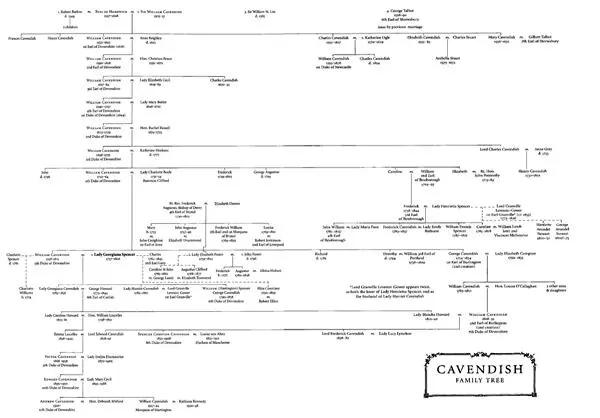
PART ONE Débutante
‘I KNOW I was handsome … and have always been fashionable, but I do assure you,’ Georgiana, Duchess of Devonshire, wrote to her daughter at the end of her life, ‘our negligence and ommissions have been forgiven and we have been loved, more from our being free from airs than from any other circumstance. * 1 Lacking airs was only part of her charm. She had always fascinated people. According to the retired French diplomat Louis Dutens, who wrote a memoir of English society in the 1780s and 1790s, ‘When she appeared, every eye was turned towards her; when absent, she was the subject of universal conversation.’ 2 Georgiana was not classically pretty, but she was tall, arresting, sexually attractive and extremely stylish. Indeed, the newspapers dubbed her the ‘Empress of Fashion’.
The famous Gainsborough portrait of Georgiana succeeds in capturing something of the enigmatic charm which her contemporaries found so compelling. However, it is not an accurate depiction of her features: her eyes were heavier, her mouth larger. Georgiana’s son Hart (short for Marquess of Hartington) insisted that no artist ever succeeded in painting a true representation of his mother. Her character was too full of contradictions, the spirit which animated her thoughts too quick to be caught in a single expression.
Georgiana Spencer was born at Althorp, outside Northampton, on 7 June 1757, the eldest child of the Earl and Countess Spencer. † She was a precocious and affectionate baby and the birth of her brother George, a year later, failed to diminish Lady Spencer’s infatuation with her daughter. Georgiana would always have first place in her heart, she confessed: ‘I will own I feel so partial to my Dear little Gee, that I think I never shall love another so well.’ 3 The arrival of a second daughter, Harriet, in 1761 did not alter Lady Spencer’s feelings. Writing soon after the birth, she dismissed Georgiana’s sister as a ‘little ugly girl’ with ‘no beauty to brag of but an abundance of fine brown hair’. The special bond between Georgiana and her mother endured throughout her childhood and beyond. They loved each other with a rare intensity. ‘You are my best and dearest friend,’ Georgiana told her when she was seventeen. ‘You have my heart and may do what you will with it.’ 4
By contrast, Georgiana – like her sister and brother – was always a little frightened of her father. He was not violent, but his explosive temper inspired awe and sometimes terror. ‘I believe he was a man of generous and amiable disposition,’ wrote his grandson, who never knew him. But his character had been spoiled, partly by almost continual ill-health and partly by his ‘having been placed at too early a period of his life in the possession of what then appeared to him inexhaustible wealth’. Georgiana’s father was only eleven when his own father died of alcoholism, leaving behind an estate worth £750,000 – roughly equivalent to £45 million today. * It was one of the largest fortunes in England and included 100,000 acres in twenty-seven different counties, five substantial residences, and a sumptuous collection of plate, jewels and old master paintings. Lord Spencer had an income of £700 a week in an era when a gentleman could live off £300 a year.
Georgiana’s earliest memories were of travelling between the five houses. She learnt to associate the change in seasons with her family’s move to a different location. During the ‘season’, when society took up residence ‘in town’ and parliament was in session, they lived in a draughty, old-fashioned house in Grosvenor Street. In the summer, when the stench of the cesspool next to the house and the clouds of dust generated by passing traffic became unbearable, they took refuge at Wimbledon Park, a Palladian villa on the outskirts of London. In the autumn they went north to their hunting lodge in Pytchley outside Kettering, and in the winter months, from November to March, they stayed at Althorp, the country seat of the Spencers for over 300 years.
When the diarist John Evelyn visited Althorp in the seventeenth century he described the H-shaped building as almost palatial, ‘a noble pile … such as may become a great prince’. 5 He particularly admired the great saloon, which had been the courtyard of the house until one of Georgiana’s ancestors covered it over with a glass roof. To Lord and Lady Spencer it was the ballroom; to the children it was an indoor playground. On rainy days they would take turns to slide down the famous ten-foot-wide staircase or run around the first-floor gallery playing tag. From the top of the stairs, dominating the hall, a full-length portrait of Robert, first Baron Spencer (created 1603), gazed down at his descendants whose lesser portraits lined the ground floor. *
Читать дальше
